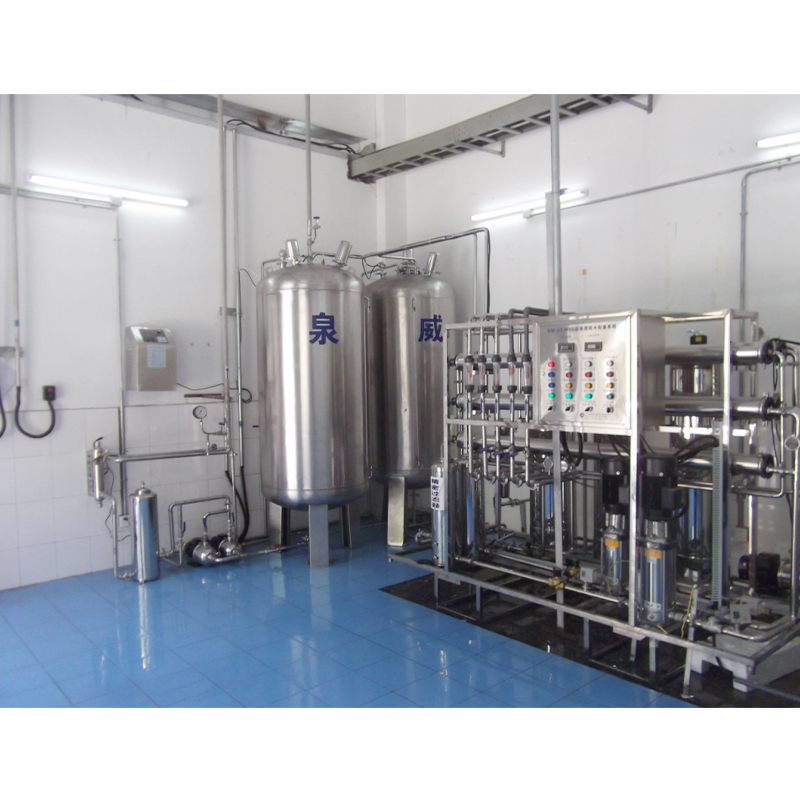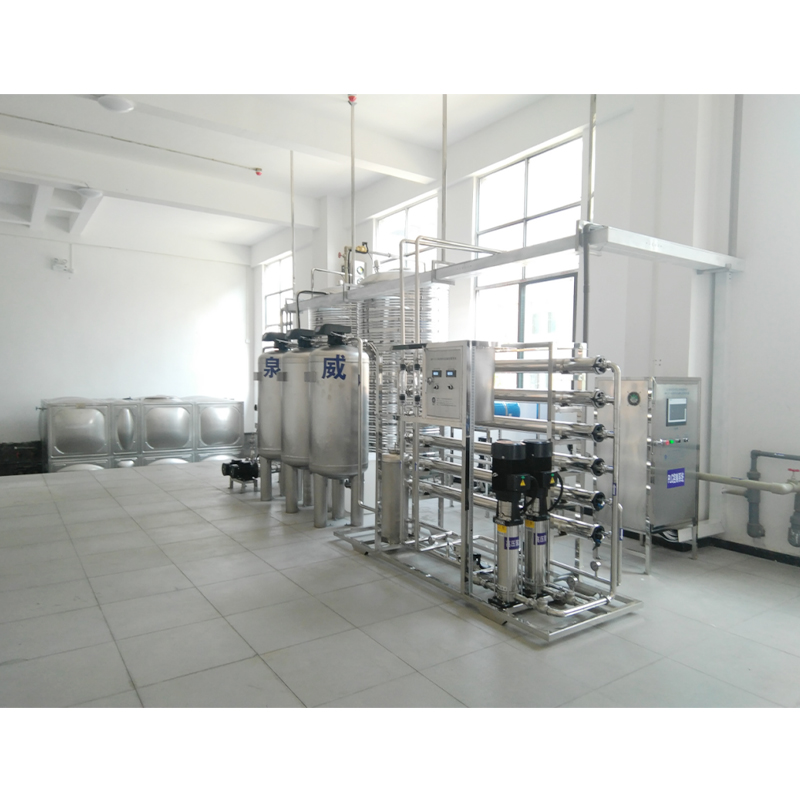What is special about the noise control of purified water preparation device?
Release Time : 2025-06-12
With the continuous improvement of water quality requirements in industrial production, purified water preparation device has become an indispensable core equipment in many industries such as pharmaceuticals, food, electronics, and hospitals. However, during the operation of the equipment, the noise problem is often easily overlooked. Excessive operating noise not only affects the working environment of the operator, but may also interfere with the normal operation of the laboratory or clean workshop.
1. Low-noise pump body design: reduce noise from the source
The water pump is one of the main sources of noise in the purified water system. In order to effectively control noise, the current mainstream purified water preparation device generally uses a low-noise variable frequency booster pump. This pump has an optimized structural design and runs more smoothly. At the same time, it has an intelligent speed regulation function, which can automatically adjust the output power according to the actual water demand, thereby avoiding the violent vibration and noise generated by traditional pumps during startup and operation.
In addition, some high-end equipment also uses new pump bodies such as silent diaphragm pumps or magnetic drive pumps, which further reduce mechanical friction and vibration, making the overall operation quieter.
2. Sound insulation materials and structural optimization: building a noise reduction barrier
In addition to noise reduction treatment for core components, the purified water preparation device also has a scientific layout on the overall structure. For example, the equipment shell is mostly made of composite materials with sound absorption and sound insulation effects, and buffer components such as shock pads and rubber seals are set inside to absorb vibration energy during operation.
Some high-precision laboratory-level equipment is even equipped with a fully enclosed silent cover, which blocks noise propagation to the maximum extent without affecting heat dissipation, so that the equipment can maintain a low sound pressure level even in continuous operation, usually controlled below 50 decibels, close to the sound intensity of daily conversation.
3. Intelligent control system: reduce noise fluctuations caused by unnecessary start and stop
Frequent start and stop will not only shorten the life of the equipment, but also cause sudden noise disturbances. To this end, the advanced purified water preparation device is equipped with an intelligent constant pressure water supply system and a pressure buffer tank, which can automatically adjust the working state according to the water use situation to avoid frequent switching pump actions caused by changes in water volume.
At the same time, the system's built-in PLC controller can realize functions such as soft start and slow stop, so that the pump can gradually accelerate or decelerate when starting and stopping, thereby greatly reducing the noise fluctuation caused by mechanical impact and improving operation stability.
4. Pipeline and interface optimization: reducing fluid noise
When water flows at high speed in the pipeline or encounters obstacles such as elbows and valves, turbulence and resonance will occur, which will cause "water hammer effect" or "whistling". In order to solve this problem, modern purified water systems have introduced large-arc transition joints, silencer elbows, and flexible connectors in the pipeline design to make the water flow smoother and effectively suppress noise.
In addition, some equipment will also install silencers or buffer chambers at key locations to absorb the vibration and noise caused by water flow pulses, thereby further improving the system's silent performance.
5. Humanized design: taking into account both performance and comfortable experience
In addition to technical optimization, many manufacturers are also working hard on user experience. For example, installing anti-skid and shock-absorbing casters at the bottom of the equipment can not only prevent abnormal noise when the equipment moves, but also effectively isolate vibrations from the ground; adding a "night mode" option on the operation panel can automatically reduce the operating frequency of the pump during a specific period of time to adapt to noise-sensitive environments.
Although these improvements in details seem small, they can significantly improve the friendliness of the equipment in practical applications, especially in scientific research institutions, hospital wards, precision laboratories and other places with high requirements for quiet environments.
Overall, modern purified water preparation devices have achieved a transition from passive protection to active optimization in terms of noise control. Whether it is pump body design, structural layout, or intelligent control and fluid optimization, each technology is constantly improving in the direction of "quiet, efficient and stable".
1. Low-noise pump body design: reduce noise from the source
The water pump is one of the main sources of noise in the purified water system. In order to effectively control noise, the current mainstream purified water preparation device generally uses a low-noise variable frequency booster pump. This pump has an optimized structural design and runs more smoothly. At the same time, it has an intelligent speed regulation function, which can automatically adjust the output power according to the actual water demand, thereby avoiding the violent vibration and noise generated by traditional pumps during startup and operation.
In addition, some high-end equipment also uses new pump bodies such as silent diaphragm pumps or magnetic drive pumps, which further reduce mechanical friction and vibration, making the overall operation quieter.
2. Sound insulation materials and structural optimization: building a noise reduction barrier
In addition to noise reduction treatment for core components, the purified water preparation device also has a scientific layout on the overall structure. For example, the equipment shell is mostly made of composite materials with sound absorption and sound insulation effects, and buffer components such as shock pads and rubber seals are set inside to absorb vibration energy during operation.
Some high-precision laboratory-level equipment is even equipped with a fully enclosed silent cover, which blocks noise propagation to the maximum extent without affecting heat dissipation, so that the equipment can maintain a low sound pressure level even in continuous operation, usually controlled below 50 decibels, close to the sound intensity of daily conversation.
3. Intelligent control system: reduce noise fluctuations caused by unnecessary start and stop
Frequent start and stop will not only shorten the life of the equipment, but also cause sudden noise disturbances. To this end, the advanced purified water preparation device is equipped with an intelligent constant pressure water supply system and a pressure buffer tank, which can automatically adjust the working state according to the water use situation to avoid frequent switching pump actions caused by changes in water volume.
At the same time, the system's built-in PLC controller can realize functions such as soft start and slow stop, so that the pump can gradually accelerate or decelerate when starting and stopping, thereby greatly reducing the noise fluctuation caused by mechanical impact and improving operation stability.
4. Pipeline and interface optimization: reducing fluid noise
When water flows at high speed in the pipeline or encounters obstacles such as elbows and valves, turbulence and resonance will occur, which will cause "water hammer effect" or "whistling". In order to solve this problem, modern purified water systems have introduced large-arc transition joints, silencer elbows, and flexible connectors in the pipeline design to make the water flow smoother and effectively suppress noise.
In addition, some equipment will also install silencers or buffer chambers at key locations to absorb the vibration and noise caused by water flow pulses, thereby further improving the system's silent performance.
5. Humanized design: taking into account both performance and comfortable experience
In addition to technical optimization, many manufacturers are also working hard on user experience. For example, installing anti-skid and shock-absorbing casters at the bottom of the equipment can not only prevent abnormal noise when the equipment moves, but also effectively isolate vibrations from the ground; adding a "night mode" option on the operation panel can automatically reduce the operating frequency of the pump during a specific period of time to adapt to noise-sensitive environments.
Although these improvements in details seem small, they can significantly improve the friendliness of the equipment in practical applications, especially in scientific research institutions, hospital wards, precision laboratories and other places with high requirements for quiet environments.
Overall, modern purified water preparation devices have achieved a transition from passive protection to active optimization in terms of noise control. Whether it is pump body design, structural layout, or intelligent control and fluid optimization, each technology is constantly improving in the direction of "quiet, efficient and stable".







